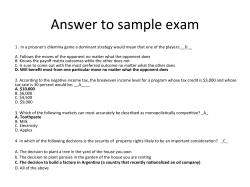
2014 AP Microeconomics Exam
The 2014 AP Microeconomics Exam Pamela Schmitt United States Naval Academy, Chief Reader Agenda • • • • Confidential and Proprietary – Not for Distribution Microeconomics Committee Chair Ellen Sewell, University of North Carolina at Charlotte Michael A. Brody, Menlo School Committee Members Joyce Jacobsen, Wesleyan University Margaret Ray, Mary Washington College Dee Mecham, The Bishop’s School Sandra K. Wright, Adlai E. Stevenson High School College Board Advisor Mary Kohelis, Brooke High School Chief Reader Pamela Schmitt, United States Naval Academy ETS Assessment Specialists Fekru Debebe Hwanwei Zhao Marwa Hassan Exams 57,000 U.S. Exams 14,000 International Exams 8,000 Alternate Exams Mean / Standard Deviation / Max 1. Monopoly 2. Labor Markets/Min Wage 3. Taxes/Tax Revenue 4.64 2.72 3.24 2.60 1.66 1.81 10 6 6 Scores 5 4 3 2 1 2014 14% 28.5% 21.9% 16.0% 19.6% Scores 5 4 3 2 1 2014 14% 28.5% 21.9% 16.0% 19.6% 2013 16.7% 28.4% 20.6% 15.4% 18.9% 2012 14.8% 28.3% 21.8% 16.3% 18.8% Students Did Great On • Equilibrium Price and Quantity - QE and PE with Supply and Demand in a product market (85% in Q1) - WE and QE with Supply and Demand in a labor market (74% in Q2) Students Did Great On • Understanding that after the imposition of a tax, quantity will fall - QT< QE (80%) • Understanding that the price the buyers pay after a tax is imposed will be higher than the equilibrium price - PB > PE , PB is on the Demand Curve at QT (69%) Students Did Great On • Understanding that an effective minimum wage is above the equilibrium wage - Wmin> WE (73%) • Monopoly Graph – Finding the profit maximizing quantity where MR = MC (68%) – Price on Demand Curve above Q* (60%) 10 Most Common Errors AP Microeconomics 2014 Overview of Trouble Spots 10. Showing the formula for calculating tax revenue 5. Explaining that constant returns to scale occur when 9. Calculating profits for a ATC is constant monopolist that over4. Determining that consumer produces surplus is zero if a monopolist 8. Calculating CS for a perfectly price discriminates monopolist that over3. Explaining the relative produces relationship between supply 7. Explaining that the MFC is and demand elasticities and equal to the equilibrium tax burden wage because firms in a PC 2. Calculating Deadweight Loss factor market are wage if the Monopolist overtakers produces 6. Illustrating that the supply curve is horizontal for a firm 1. Showing Profit with perfect price discrimination in a PC labor market Overview of Trouble Spots 10. Showing the formula for calculating tax revenue 5. Explaining that constant returns to scale occur when 9. Calculating profits for a ATC is constant monopolist that over4. Determining that consumer produces surplus is zero if a monopolist 8. Calculating CS for a perfectly price discriminates monopolist that over3. Explaining the relative produces relationship between supply 7. Explaining that the MFC is and demand elasticities and equal to the equilibrium tax burden wage because firms in a PC 2. Calculating Deadweight Loss factor market are wage if the Monopolist overtakers produces 6. Illustrating that the supply curve is horizontal for a firm 1. Showing Profit with perfect price discrimination in a PC labor market Overview of Trouble Spots 10. Showing the formula for calculating tax revenue 5. Explaining that constant returns to scale occur when 9. Calculating profits for a ATC is constant monopolist that over4. Determining that consumer produces surplus is zero if a monopolist 8. Calculating CS for a perfectly price discriminates monopolist that over3. Explaining the relative produces relationship between supply 7. Explaining that the MFC is and demand elasticities and equal to the equilibrium tax burden wage because firms in a PC 2. Calculating Deadweight Loss factor market are wage if the Monopolist overtakers produces 6. Illustrating that the supply curve is horizontal for a firm 1. Showing Profit with perfect price discrimination in a PC labor market 10. Micro 3 (c) Question: Assume that gasoline is sold in a competitive market in which demand is relatively inelastic and supply is relatively elastic: (c) Using the labeling on your graph, explain how to calculate the total tax revenue collected by the government. 31.4% of students answered this correctly 10. Micro 3 (a), graph similar 10. Micro 3 (c) Question: Assume that gasoline is sold in a competitive market in which demand is relatively inelastic and supply is relative elastic: (c) Using the labeling on your graph, explain how to calculate the total tax revenue collected by the government. Answer: (PB - PS ) * QT = 2 * QT Key is making sure PB and PS are not equal to PE 9. Micro 1 (c)(i) Question: Now assume that the monopolist produces 10 units. Using the numbers given in the graph calculate each of the following. Show your work. (i) The monopolist’s profit 27.4% Answered Correctly Q 9. Micro 1 (c)(i) Answer: Profit = (P – ATC)*Q =($10 – $20)*10 Loss of $100 Q 8. Micro 1 (c)(ii) Question: Now assume that the monopolist produces 10 units. Using the numbers given in the graph calculate each of the following. Show your work. (ii) The consumer surplus 24.6% Answered Correctly Q 8. Micro 1 (c)(ii) Answer: CS = ½ b*h = ½ ($60 –$10)*10 = ½ ($50)*10 CS = $250 Must show calculation! Q 7. Micro 2 (b) Question: Ray’s Stable hires workers in a perfectly competitive factor market for unskilled labor. (b) Is the marginal factor cost of unskilled labor for Ray’s Stable greater than, less than or equal to WE (equilibrium wage for the labor market found in (a))? Explain. 24% of students answered this correctly. 7. Micro 2 (b) Question: (b) Is the marginal factor cost of unskilled labor for Ray’s Stable greater than, less than, or equal to WE? Explain. Answer: The marginal factor cost is equal to WE because the firm is a wage taker in the labor market. 6. Micro 2 (a)(ii) Question: Ray’s Stable hires workers in a perfectly competitive factor market for unskilled labor. (a) Using correctly labeled side-by-side graphs for the labor market and Ray’s Stable, show each of the following. (ii) The wage paid by Ray’s Stable and the quantity of unskilled labor hired, labeled WR and QR, respectively. 6. Micro 2 (a)(ii) W D S Wage WR WF S MFC QF QR 6. Micro 2 (a)(ii) Answer: (ii) WR is equal to the horizontal supply curve for Ray’s Stables. Wage WR S=MFC D=MRP QR (24% answered correctly) 5. Micro 1 (b) Question: At the profit maximizing quantity from part (a)(i), is the monopolist experiencing economies of scale? Explain. Q 23.2% Answered Correctly 5. Micro 1 (b) Answer: The firm is not experiencing economies of scale. Explain: LRATC is not downward sloping. The ATC remains constant as output increases. Q 23.2% Answered Correctly 4. Micro 1 (e)(ii) Question: Suppose the monopolist perfectly price discriminates and chooses the quantity that maximizes profit. Determine the dollar value of each of the following: (i) The consumer 22.9% Answered Correctly surplus • First identify Qperfect price discrimination = 8 Qpd 4. Micro 1 (e)(ii) Answer: The consumer surplus under perfect price discrimination is equal to zero. This results from understanding that perfect price discrimination implies each consumer is charged their marginal benefit (MB) or the maximum price the consumer is willingness to pay. Since CS is the difference between the MB and the price, consumer surplus is zero. 3. Micro 3 (d) Question: Assume that gasoline is sold in a competitive market in which demand is relatively inelastic and supply is relatively elastic. (d) Will the tax burden fall entirely on buyers, entirely on sellers, more on buyers and less on sellers, more on sellers and less on buyers, or equally on buyers and sellers? Explain. 22.5% Answered Correctly 3. Micro 3 (d) (d) Will the tax burden fall entirely on buyers, entirely on sellers, more on buyers and less on sellers, more on sellers and less on buyers, or equally on buyers and sellers? Explain. Answer: The tax burden will fall more on buys and less on sellers because the demand curve is more inelastic than the supply curve. Key is the comparison between elasticity of supply and demand. 22.5% of students answered this correctly 2. Micro 1 (c)(iii) Question: Now assume that the monopolist produces 10 units. Using the numbers given in the graph calculate each of the following. Show your work. (iii) The deadweight loss 22.3% Answered Correctly Q • Calculate DWL triangle: DWL = 1/2 ($20-$10) × (10-8) = $10 1. Micro 1 (e)(i) Question: Suppose the monopolist perfectly price discriminates and chooses the quantity that maximizes profit. Determine the dollar value of each of the following: (i) The monopolist’s 15.9% Answered Correctly profit • First identify Qperfect price discrimination = 8 Qpd • Calculate profit triangle: • Profits = 1/2[($60 − $20) × 8] = $160 Questions?
© Copyright 2025










